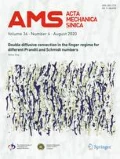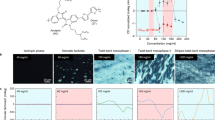Abstract
Self-shaping materials such as shape memory polymers have recently drawn considerable attention owing to their high shape-changing ability in response to changes in ambient conditions, and thereby have promising applications in the biomedical, biosensing, soft robotics and aerospace fields. Their design is a crucial issue of both theoretical and technological interest. Motivated by the shape-changing ability of Towel Gourd tendril helices during swelling/deswelling, we present a strategy for realizing self-shaping function through the deformation of micro/nanohelices. To guide the design and fabrication of self-shaping materials, the shape equations of bent configurations, twisted belts, and helices of slender chiral composite are developed using the variation method. Furthermore, it is numerically shown that the shape changes of a chiral composite can be tuned by the deformation of micro/nanohelices and the fabricated fiber directions. This work paves a new way to create self-shaping composites.
Similar content being viewed by others
References
Fratzl, P.: Biomimetic materials research: What can we really learn from nature’s structural materials? J. R. Soc. Interface 15, 637–642 (2007)
Bhushan, B.: Biomimetics: Lessons from nature-An overview. Phil. Trans. R. Soc. A 367, 1445–1486 (2009)
Youngblood, J.P., Sottos, N.R.: Bioinspired materials for selfcleaning and self-healing. MRS Bull. 33,732–737 (2008)
Chen, Q., Pugno, N.M.: Bio-mimetic mechanisms of natural hierarchical materials: A review. J. Mech. Behav. Biomed. 19, 3–33 (2013)
Ji, B.H., Gao, H.J.: Mechanical principles of biological nanocomposites. Annu. Rev. Mater. Res. 40, 77–100 (2010)
Chen, S.H., Gao, H.J.: Bio-inspired mechanics of reversible adhesion: orientation-dependent adhesion strength for nonslipping adhesive contact with transversely isotropic elastic materials. J. Mech. Phys. Solids 55, 1001–1015 (2007)
Liu, J.L., Mei, Y., Xia, R.: A new wetting mechanism based upon triple contact line pinning. Langmuir 27, 196–200 (2011)
Shao, Y., Zhao, H.P, Feng, X.Q., et al.: Discontinuous crackbridging model for fracture toughness analysis of nacre. J. Mech. Phys. Solids 60, 1400–1419 (2012)
Erb, R.M., Sander, J.S., Grisch, R., et al.: Self-shaping composites with programmable bioinspired microstructures. Nat. Commun. 4, 1712 (2013)
Studart A.R., Erb, R.M.: Bioinspired materials that self-shape through programmed microstructures. Soft Matt. 10, 1284–1294 (2013)
Mather, P.T., Luo, X., Rousseau, I.A.: Shape memory polymer research. Annu. Rev. Mater. Res. 39, 445–471 (2009)
Thérien-Aubin, H., Wu, Z.L., Nie, Z., et al.: Multiple shape transformations of composites hydrogel sheets. 135, 4834–4839 (2013)
Dawson, C., Vincent, J.F.C., Rocca, A.M.: How pine cones open. Nature 290, 668 (1997)
Armon, S., Efrati, E., Kupferman, R., et al.: Geometry and mechanics in the opening of chiral seed pods. Science 333, 1726–1730 (2011)
Elbaum, R., Zaltzman, L., Burgert, I., et al.: The role of wheat awns in the seed dispersal unit. Science 316, 884–886 (2007)
Abraham, Y., Tamburu, C., Klein, E., et al.: Tilted cellulose arrangement as a novel mechanism for hygroscopic coiling in the stork’s bill awn. J. R. Soc. Interface 9, 640–647 (2012)
Gerbode, S.J., Puzey, J.R., McCormick, A.G., et al.: How the Cucumber tendril coils and overwinds. Science 337, 1087–1091 (2012)
Wang, J.S., Ye, H.M., Qin, Q.H., et al.: Anisotropic surface effects on the formation of chiral morphologies of nanomaterials. Proc. R. Soc. A 468, 609–633 (2012)
Wang, J.S., Feng, X.Q., Wang, G. F., et al.: Twisting of nanowires induced by anisotropic surface stresses. Appl. Phys. Lett. 92, 191901 (2008)
Chen, Z., Majidi, C., SroIovitz, D.J., et al.: Tunable helical ribbons. Appl. Phys. Lett. 98, 011906 (2011)
Wang, J.S., Wang, G., Feng, X.Q., et al.: Hierarchical chirality transfer in the growth of Towel Gourd tendrils. Sci. Rep. 3, 3102 (2013)
Gao, X.P., Ding, Y., Mai, W.J., et al.: Conversion of zinc oxide nanobelts into superlattice-structured nanohelices. Science 309, 1700–1704 (2005)
Kong, X.Y., Wang, Z.L.: Spontaneous polarization-induced nanohelixes, nanospings, and nanorings of piezoelectric nanobelts. Nano. Lett. 3, 1625–1631 (2003)
Korgel, B.A.: Nanospings take shape. Science 309, 1683–1684 (2005).
Guo, W.L., Guo, Y.F.: Giant axial electrostrictive deformation in carbon nanotubes. Phys. Rev. Lett. 91, 115501 (2003)
Goriely, A., Neukirch, S.: Mechanics of climbing and attachment in twining plats. Phys. Rev. Lett. 97, 184302 (2006)
Marklund, E., Varna, J.: Modeling the effect of helical fiber structure on wood fiber composite elastic properties. Appl. Compos. Mater. 16, 245–262 (2009)
Wang, J.S., Wang, G.F., Feng, X.Q., et al.: Surface effects on the superelasticity of nanohelices. J. Phys.: Condens. Matter. 24, 265303 (2012)
Whitman, A.G., Desilva, C.N.: An exact solution in a nonlinear theory of rods. J. Elasticity 4, 265–280 (1974)
Tu, Z.C., Li, Q.X., Hu, X.: Theoretical determination of the necessary conditions for the formation of ZnO nanorings and nanohelices. Phys. Rev. B 73, 115402 (2006)
Gao, L.T., Feng, X.Q., Yin, Y.J., et al.: An electromechanical liquid crystal model of vesicles. J. Mech. Phys. Solids 59, 2844–2862 (2008)
Author information
Authors and Affiliations
Corresponding author
Additional information
The project was supported by the National Basic Research Program of China (2012CB937500), Grants-in-Aid for Scientific Research (21226005) from the Japan Society for the Promotion of Science (JSPS), the National Natural Science Foundation of China (11272230 and 11172207), and the Basic Application and Advanced Technology Research Project in Tianjin (11JCYBJC09700).
Rights and permissions
About this article
Cite this article
Rong, QQ., Cui, YH., Shimada, T. et al. Self-shaping of bioinspired chiral composites. Acta Mech Sin 30, 533–539 (2014). https://doi.org/10.1007/s10409-014-0012-2
Received:
Accepted:
Published:
Issue Date:
DOI: https://doi.org/10.1007/s10409-014-0012-2




